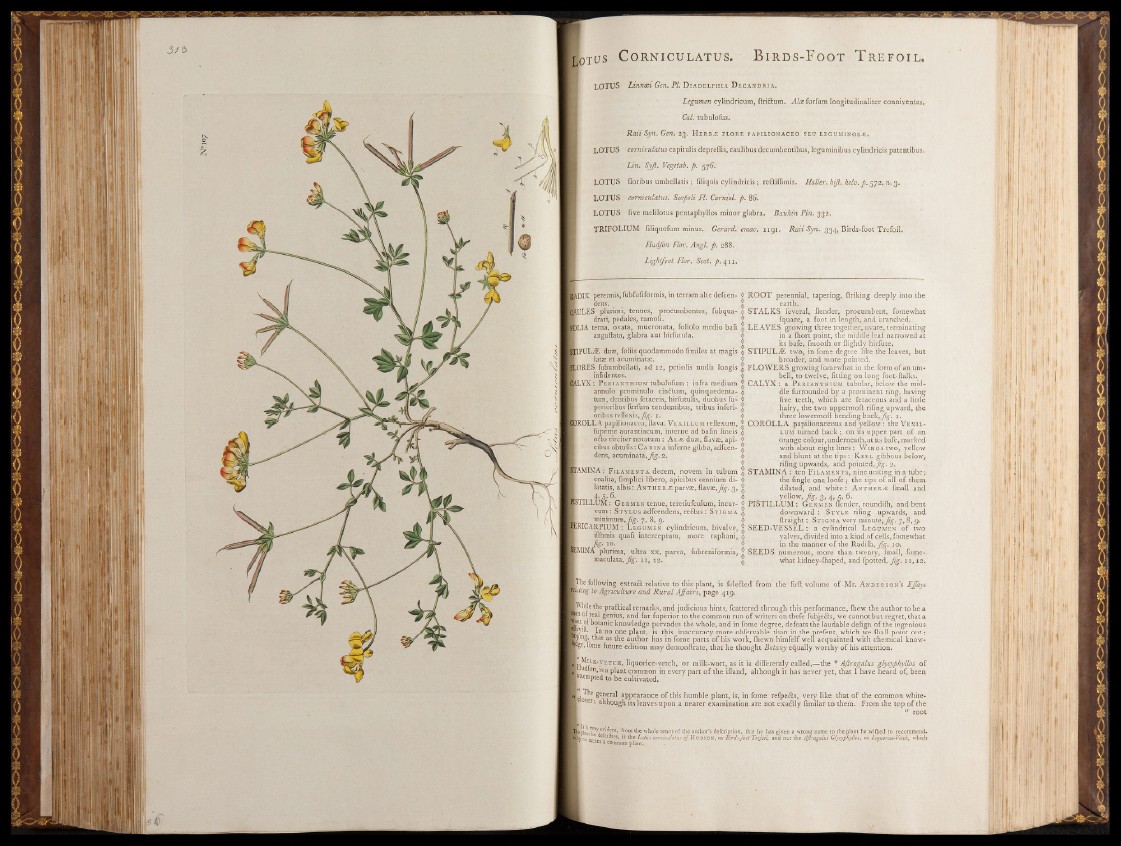
f a ß
LOTUS Linncei Gen. PL D iadelphia Decandria.
Legimen cylindricum, ftri&um. Aloe furfum longitudinaliter conniventes.
Cal. tubulofus.
Raii Syn. Gen. 23. Herbæ flore papilionaceo seu leguminosæ.
LOTUS corniculatus capitulis depreflis, caulibus decumbentibus, leguminibus cylindricis patentibus.
Lin. Syß. Vegetab. p . 576.
LOTUS floribus umbellatis ; filiquis cylindricis ; re&iffimis. Haller, hifi.helv. p.. 572. to, '3.
LOTUS corniculatus. Scopoli FI. Carniol. p. 86.
LOTUS five melilotus pentaphyllos minor glabra. Baufiin Pin. 332.
TRIFOLIUM filiquofum minus. Gerard, emac. 1191. Raii Syn. 334, Birds-foot Trefoil.
Hud/bn Flor. Angl. p. 288.
Lightfpot Flor. Scot. p. 411.
pRADIX perennis, fubfufiformis, in terram alte defcen- <
dens. ]
[CAULES plurimi, tenues, procumbentes, fubqua- i
drati, pedales, ramofii
P'OLIA terna, ovata, mucronata, foliölo medio bafi ,
anguftata, glabra aut hirfutula. *
BTIPUL./E duas, foliis quodammodo fimiles at magis \
latse et acuminatas.
§LORES fubumbellati, ad 12, petiolis nudis longis \
infidentes. i
p\LYX: Perianthiüm tubulöfum : infra medium '
annulo prominulo cinftum, quinquedenta- ,
turn, dentibus fetaceis, hirfutulis, duobus fu- i
, perioribus furfum tendentibus, tribus inferi- ]
oribus reflexis,^. 1.
KJOROLLA papilionacea,flava: V exillum reflexum, 1
fuperne aurantiacum, interne ad bafin lineis i
o&o circiter notatum: A l e duae, flavae, api- <
cibus obtufis: Carina inferne gibba,adfcen- ]
dens, a c um in a t a , 2. i
STAMINA: Filamenta decern, novem in tubum ,
coalita, fimplici libero, apicibus omnium di- *
latatis, albis: A n th er s parvae, flavae,fig . 3, '
I 4, 5, 6.
■ STILLUM: Ger men teriue, teretiufculum, incur- *
vum : Stylus adfcendens, re&us: Stigma ’
r minimum,jig*. 7, 8,9. ^
KRICARPIUM: L egumen cylindricum, bivalve, *
ifthmis quafi interceptum, more raphani, *
■ , fig. 10.
KMINA plurima, ultra xx, parva, fubreniformia, ’
maculata, ^g-. 11, 12.
ROOT perennial, tapering, ftriking deeply into the
earth.
STALKS feveral, flender, procumbent, fomewhat
fquare, a foot in length,, and branched.
LEAVES growing three together, o.vate, terminating
in a fhort point, the middle leaf narrowed at
its bafe, fmooth or flightly hirfute.
STIPULAi. two, in fome degree like the leaves, but
broader, and more pointed.
FLOWERS growing fomewhat in the form o f an um-
bell, to twelve, fitting on long foot-ftalks.
C A L YX : a Perianthium tubular, below the middle
furrounded by a prominent ring, having
five teeth, which are fetaceous and a little
hairy, the two uppermoft riling upward, the
three lowermoft bending back,^g\ 1.
COROLLA papilionaceous and yellow: the V exillum
turned back ; on its upper part of an
orange colour, underneath, at its bafe, marked
with about eight lines: Wings two, yellow
and blunt at the tips: K eel gibbous below,
riling upwards, and p o i n t e d , 2.
STAMINA : ten Filaments, nine uniting in a tube;
the (ingle one. loofe ; the tips of all of them
dilated, and white : A n thers fmall and
yellow, J ig . H 4, 5 , 6.
PISTILLUM: G ermen flender, roundifh, and bent
downward : Sty le rifing upwards, and
ftraight: Stigma very minute,^. 7, 8,9.
SEED-VESSEL : a cylindrical L egumen o f two
valves, divided into a kind of cells, fomewhat
in the manner of the Radifh, fig . 10.
SEEDS numerous, more than twenty, fmall, fomewhat
kidney-Ihaped, and fpotted, fig . 11,12.,
The following extraft relative to this plant, is fele&ed from the firfl: volume of-Mr. A nderson’s Effays
mating to Agriculture and Rural Affairs, page 419.
ft^hile the pra&ical remarks, and judicious hints, fcattered through this performance, (hew the author to be a
Ban of real genius, and far fuperior to the common run of writers on thefe fubje&s, we cannot but regret, that a
otan*c knowledge pervades the whole, and in fome degree, defeats the laudable defign of the ingenious
In no one plant, is this inaccuracy more obfervable than in the prefent, which we (hall point out;
that as the author has in fome parts of his work, (hewn himfelf well acquainted with chemical know-
■ ge, lome future edition may demonftrate, that he thought Botany equally worthy o f his attention.
1« L^ILK'y ETCH, liquorice-vetch, or milk-wort, as it is differently called,— the * Afiragalus glycyphyllos of
|puaionj]s a pjant com mo n jn e v e r y part Qf the ifland, although it has never yet, that I have heard of, been
»tempted to be cultivated. •
it» c1| 2he general appearance o f this humble plant, is,
fome refpe£ls, very like that of the common white-
» °ver; although its leaves upon a nearer examinat
examination are not exaflly fimilar to them. From the top of the
■ is very evident,
gP'ant he defcribes
pynomeans à Co _'
roirl the whole tenor of the author’s defcription, that he has given a wrong name to the plant he jvilhed to recommend,
s the Lotus coridcu/alws of Hudson, or Birds foot Trefoil, and not the Afiragalus Glycyphyllos, or Liquorice-Vetch, which
«plant..